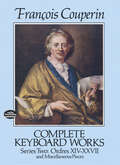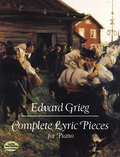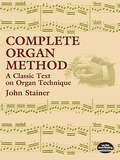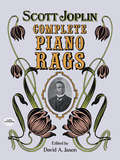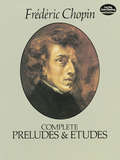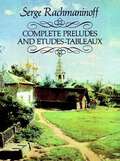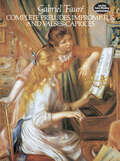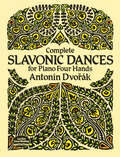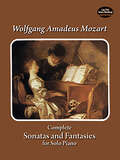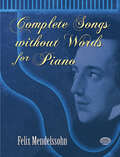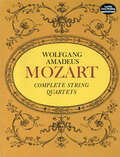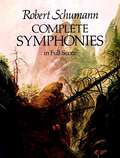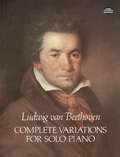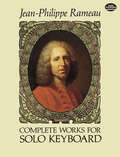- Table View
- List View
Complete Keyboard Works, Series Two: Ordres XIV-XXVII and Miscellaneous Pieces (Dover Classical Piano Music)
by Francois Couperin"His melodic imagination displays admirable freshness. He possesses a delicate harmonic sense. His themes show the inspirations of an impassioned musician: perfectly created, firm in line, vivid, and enduring in color. His art never wavers; it consistently exhibits a magnificent technique." -- John Gillespie, Five Centuries of Keyboard MusicThis famous edition, prepared a century ago by Johannes Brahms and Friedrich Chrysander, presents all of the 27 keyboard suites, or Ordres, by the great French composer François Couperin (1668-1733). Also included are the Allemande and 8 Preludes from Couperin's famous harpsichord treatise, L'Art de Toucher le Clavecin.In these magnificent works (there are over 200 compositions in the two volumes) lies the supreme achievement of French keyboard music, a rich source of subtle, sometimes startling, always pleasurable music for keyboard artists and students at every level of expertise. The moods, rhythms, and melodies of these distinctive compositions range across a broad musical spectrum, from crisp gavottes to noble sarabandes, from flowing allemandes to lively gigues. Some of the pieces suggest carnival merriment, others tender reflection; most have colorful and mysterious names. Couperin's virtuoso command of harpsichord style, his magnificent technique, and ever-fresh melodic imagination pervade them all.Witty, graceful, and tuneful, the keyboard works of Couperin represent a wonderful legacy of late-baroque masterpieces. Beautifully reproduced in this inexpensive edition, they make abundantly clear the justice of Bach's intense admiration for Couperin's music and the aptness of the French master's surname -- "le grand."Note: Series Two contains Ordres 14-27 plus 8 Preludes and Allemande from L'Art de Toucher le Clavecin.
Complete Lyric Pieces for Piano (Dover Music For Piano Ser.)
by Edvard GriegBetween 1867 and 1901, Edvard Grieg (1843–1907) wrote ten sets of little mood pictures for piano that display his great musical gifts at their lyrical best. Charming works of elegant simplicity and warmth, they have become cornerstones of the piano repertoire, favorites of both amateur and professional musicians and their audiences.This authoritative edition presents all 66 of these piano jewels in one finely made yet inexpensive volume. Although technically uncomplicated and reasonably easy to master, the Lyric Pieces evoke with startling freshness a wide emotional range, often bringing into play the varied moods and idioms of Norwegian folk music, an evergreen source of Grieg's inspiration. They vary in mood from the serene sadness of "Berceuse" and the nostalgic yearning of "To Spring" to the fanciful "Elves' Dance" and the joyful "Wedding Day at Troldhaugen."In many passages, the music exhibits harmonies that were novel for the time — harmonies recognizably late-romantic in style, but clearly anticipating the impressionism of Debussy, Ravel, and others. Pianists at every level of accomplishment will find this volume of delightful and moving works, reprinted here from the original editions published by C. F. Peters of Leipzig, a perfect companion for hours of musical pleasure.
Complete Organ Method: A Classic Text on Organ Technique
by F. Flaxington Harker John StainerThis classic method for beginners provides a brief history of the instrument followed by an explanation of organ construction, a thorough discussion of the various stops and their management, and a major section devoted to practical study -- including detailed pedal techniques, precision in manual touch, hand-foot independence, pedal scales, trios, and finger substitution to achieve a perfect legato. With the author's meticulous explanations and accompanying illustrations, students can actually teach themselves to play! Seven organ pieces complete the original edition, including five of Stainer's own works and two pieces by Guilmant; three additional works have been added to round out this Dover edition.
Complete Piano Rags
by Scott JoplinThroughout history, few musical crazes have hit with such impact, had such a heyday and lingered so hauntingly as ragtime. Ragtime arrived on the upswing of Tin Pan Alley, when the popularity of pianos in the home was reaching its peak and an endless stream of sheet music flowed out to meet the demand. In the early 1900s, no name was more prominent on those sheet-music covers and no one wrote ragtime music more brilliantly than Scott Joplin. This wonderful book brings together in one superbly produced playing edition all thirty-eight of Scott Joplin's piano rags, including his six collaborations, plus Joplin's own primer on how to play ragtime, the "School of Ragtime." Each rag has been reprinted, along with its sheet-music cover, from the original publisher's edition. At the Williams' Brothers saloon in Sedalia, Missouri, Scott Joplin was known as "The Entertainer," and in 1897, in the upstairs room called the Maple Leaf Club, he wrote the rag that would one day be the first to sell over a million copies in sheet-music form. In time the "Maple Leaf Rag" also became the most recorded composition on piano roll, with forty known versions. Most of Joplin's other rags were hits as well. Many bear the playful names that were given most rags, names like "The Strenuous Life," "Heliotrope Bouquet," and his last published piece, the "Silver Swan Rag." One of them, "The Entertainer," triggered a major revival of interest in his work when it was incorporated into the score of the popular film The Sting. All of them are here, each bearing the mark of Joplin's supreme originality. As ragtime authority David A. Jasen observes in his Introduction: "For pianists everywhere, this folio contains ragtime masterpieces which, when learned, will provide unlimited joy."
Complete Piano Sonatas
by Alexander ScriabinLike Chopin, Scriabin made the piano the focus of his art. Among the supreme achievements of that art are the ten sonatas he composed between 1892 and 1913, works that abundantly display both his technical virtuosity and the exhilarating emotional gamut he ranged with such individuality.All ten of Scriabin's sonatas are reprinted here from the authoritative Russian edition published in 1964. The first four reveal the influences of the pianism of Chopin and Liszt. The subsequent sonatas richly display Scriabin's emerging impressionist techniques and his deep attraction to mysticism, which progressively conjured a more and more ethereal framework of sound, now brooding and introspective, now rhapsodic and exultant.In both their technical requirements and their emotional demands, these brilliant works will offer pianists a deeply satisfying challenge. Nonpianists will also enjoy this finely made edition, with which they may follow, music in hand, the growing number of loved and recorded performances of these masterpieces.
Complete Piano Sonatas, Volume I: Comb Bound Book (Dover Classical Piano Music #2)
by Joseph HaydnThe towering composer who perfected the early symphonic form and invented the modern string quartet also left his indelible mark on the sonata. During 50 years of inspired creative effort, Haydn experimented constantly with the sonata form, adding a clear thematic structure to the tonal design inherited from earlier composers.This comprehensive new playing edition contains 52 sonatas by the master -- a treasury of keyboard compositions in which echoes of the baroque and harbingers of romanticism blend with the lucidity and elegance of 18th-century classicism. Here is a remarkably convenient and reliable presentation of more than 50 of Haydn's efforts in the form, from the early divertimento-like sonatas to the masterworks of the later years, culminating in the sublime Sonata No. 52 in E-flat Major.Reprinted in two volumes from an authoritative Breitkopf & Härtel edition, the sonatas are arranged in a chronological sequence based on recent scholarship. Extremely clear and readable, with ample space for notes, this Dover edition is a must for serious pianists, students, and music lovers in general. It is an excellent, inexpensive means to study and savor the inventive daring, freedom, and mastery that Haydn brought to the piano sonata.
Complete Piano Sonatas, Volume II
by Ludwig Van BeethovenThe entire corpus of Beethoven's piano sonatas is contained in this two-volume work -- 32 sonatas in all. Volume One contains the fifteen sonatas from Beethoven's first period, including the popular Pathétique, Moonlight, and Pastorale sonatas. Volume Two contains the seventeen sonatas from Beethoven's second and third periods, including the Waldstein, the Appassionata, and the Hammerklavier.The music is reproduced directly from the exemplary Universal-Edition set edited by Heinrich Schenker. Combining scrupulous scholarship and profound artistic vision, Schenker achieved an edition which is universally admired by musicians and scholars. He used more autographs as sources than any previous editor of the sonatas, and he was the first to reproduce in print the visual impression of the autographs. For this Dover edition, Schenker's footnotes have been translated into English and his preface retranslated. A new introduction by Carl Schachter has also been included.Noteheads have been reproduced in a size enough to be read easily at the keyboard. Margins and spaces between staves are generous, permitting insertion of written notes, analysis, fingerings, etc. Running measure numbers and many fingerings have already been included by the editor -- the last a particularly unusual and valuable feature of this edition. This edition will be welcomed by all pianists, both professional and amateur, for its accuracy and reliability; it is highly desirable for instruction, study, reference, and enjoyment.
Complete Preludes and Etudes (Dover Classical Piano Music)
by Frédéric ChopinChopin’s piano works are of such uniformly high quality that they are all absolutely essential in the repertoire of any aspiring pianist. The Preludes and Etudes are exquisitely beautiful examples of his genius. Numbering 52 pieces in all, they are reproduced here from the authoritative Mikuli edition and are available for the first time in a low-priced, one-volume publication. The opus listings are: 25 Preludes — Op. 28, Nos. 1–24; Prelude in C-sharp Minor, Op. 45. 27 Etudes — Op. 10, Nos. 1–12; Op. 25, Nos. 1–12; and Trois Nouvelles Etudes Unabridged (1998) republication of works from an authoritative early edition. New unified table of contents.
Complete Preludes and Etudes-Tableaux (Dover Music For Piano Ser.)
by Serge RachmaninoffThe 24 preludes and 17 etudes-tableaux of Serge Rachmaninoff include what are possibly his finest compositions for solo piano. Each of these masterly works is included in this complete collection, reproduced from recent, authoritative Russian editions. They include: Prelude, Op. 3, No. 2; Ten Preludes, Op. 23; Thirteen Preludes, Op. 32; Eight Etudes-tableaux, Op. 33; Nine Etudes-tableaux, Op. 39. Among these are the enormously popular C-sharp minor prelude, Op. 3, No. 2; the G-minor prelude, Op. 23, No. 5; and the B-minor prelude, Op. 32, No. 10 — classics that have made Rachmaninoff one of the most performed and recorded modern composers.Each of these works reflects Rachmaninoff's emotional intensity, his thrilling gifts as a melodist and his ability to crystallize perfectly a particular mood or sentiment. In their sonorous textures and rich embellishment, they reflect as well his sovereign command of keyboard technique and his spectacular gifts as a pianist (he was one of the very greatest pianists of the 20th century). This beautifully produced yet inexpensive edition will provide both amateur and professional pianists a lifetime of study and enjoyment, and will afford music lovers as well the deep pleasures of following, music in hand, live and recorded performances of these keyboard masterpieces.
Complete Preludes, Books 1 and 2 (Dover Classical Piano Music)
by Claude DebussyHere, in one volume, are two bodies of work that, perhaps more than any others, reveal the essence of Claude Debussy's extraordinary expressiveness and his innovative gifts for musical imagery. Each book contains twelve preludes for the piano, many of them known to today's musical audiences because of their great popularity with pianists worldwide. Ranging from the mystical "La Cathédrale engloutie" to the capricious "Ondine" to the explosive "Feux d'artifice," they offer special joys to pianists of varying levels of ability.Other favorites from the piano repertoire in this collection include: "Danseuses de Delphes," "Ce qu'a vu le Vent d'Ouest," "La fille aux cheveux de lin," "La danse de Puck," and "Feuilles mortes." Some are technically simple, others comparatively difficult. All of them afford pianists an unparalleled opportunity to explore and develop their expressive range.This authoritative edition of the complete Preludes, with a helpful glossary of French terms, has been carefully printed on durable paper and sturdily bound to provide students and lovers of fine music a lifetime of study and enjoyment of these beloved masterpieces of piano composition.
Complete Preludes, Impromptus and Valses-Caprices
by Gabriel FauréGabriel Fauré (1845-1924) enriched the literature of the piano with freshly melodic, elegantly wrought compositions that embody the aristocratic qualities of the French tradition. This superbly produced volume brings together in one authoritative playing edition one of the most important segments of his works for piano: all of his nine Preludes, five Impromptus, and four Valses-Caprices.Each of these distinctive compositions, so often heard today in concert and recital halls around the world and frequently recorded by leading pianists, reveal Fauré's lyrical melodic gifts and innovative harmonies and the classical qualities of clarity, balance, and serenity characteristic of his work.Pianists of intermediate and advanced skills will find in these richly varied compositions -- unavailable elsewhere in one volume -- a unique opportunity to explore the elegant artistry of one of the most gifted and influential composers of the French school. Music lovers at every level of accomplishment will discover in this well-made, yet inexpensive edition a most satisfying way to savor fine music: to follow phrase by phrase, music in hand, a live or recorded performance.
Complete Shorter Works for Solo Piano
by Johannes BrahmsThe entire corpus of Brahms's short piano pieces is contained in this volume: the delightful and familiar Waltzes; the effective Scherzo in E-flat Minor; the satisfying Eight Pieces; the two Rhapsodies; the Fantasies -- among the most perfectly finished works Brahms ever wrote -- the three Intermezzi; the Intermezzi, Ballade, and Romance comprising Six Pieces; and the superlative Intermezzi and Rhapsody that make up the final Four Pieces.The music is reproduced directly from the definitive Vienna Gesellschaft der Musik-freunde edition, edited by its renowned musicologist, Eusebius Mandyczewski, who made his revisions from original sources, often Brahms's own manuscripts. For this Dover edition, the Editor's Preface (Revisionsbericht) and the Table of Contents have been translated into English.Noteheads have been reproduced in a size large enough to be read easily at the keyboard. Margins and spaces between staves are generous, permitting insertion of written notes, analysis, fingertips, running measure numbers, etc. This edition will be welcomed, not only by the classical pianist, but by all who will find it highly practical and convenient for instruction, study, reference, enjoyment, and virtually any other purpose.
Complete Slavonic Dances for Piano Four Hands
by Antonin DvorákThe two series of piano duets combined in this volume are among Dvořák's most famous compositions and among the most performed works in the piano four hands repertoire. The composer intended them as artistic stylizations of typical Slavonic dances such as the furiant, the dumka, the polka, the skočná, the odzemek, and the kolo.The first series of eight dances, Opus 46 (1878), is full of joy and vitality. The second set of eight dances, Opus 72 (1886), is slightly more somber and meditative. Both series will delight pianists with their exciting rhythms and fresh, highly individual invention. They are reprinted here from the authoritative Czechoslovakian editions of Dvořák's complete works.
Complete Sonatas and Fantasies for Solo Piano (Dover Music for Piano)
by Wolfgang Amadeus MozartMozart's piano sonatas and fantasies comprise a body of work so central to the keyboard repertoire that a thorough acquaintance with them is as essential for every serious pianist as it is rewarding for piano students at all levels.This excellent edition contains all 19 sonatas and 4 fantasies, including works that have been erroneously omitted from most Mozart editions. Ranging in their technical demands from the relatively easy Sonata in C Major, K545 (one of the most popular piano works ever composed), to the profoundly moving Fantasy in D Minor, K397, and the challenging Sonata No. 19 in D Major, K576, these works are imbued with the clarity, grace, variety, and limitless invention that have made them perennial favorites with performers and audiences alike. Reprinted from authoritative editions, including Breitkopf & Härtel's Complete Works, this volume is among the lowest-priced and most thorough editions now available.
Complete Sonatas, Invitation to the Dance and Other Piano Works
by Carl Maria WeberA virtuoso of the piano and a pioneer of musical Romanticism, Carl Maria von Wolfe (1786-1926) wrote piano music of elegance and grandeur enhanced with bravura technical effects that profoundly influenced later 19th-century piano music. This volume presents virtually all Weber's works for piano solo: the four piano sonatas -- Opus 24 in C Major (1812), Opus 39 in A-flat Minor (1816), Opus 49 in D Minor (1816), and Opus 70 in E Minor (1822) -- considered the core of his output; his most popular piano composition, Invitation to the Dance, a waltz later orchestrated by Berlioz and used for the celebrated ballet Le Spectre de la Rose; eight lively and engaging sets of variations; and the dazzling Momento Capriccioso, Grande Polonaise, Rondo Brillante, and Polacca Brillante. Pianists will enjoy exploring this richly varied collection of piano masterworks, reprinted from the authoritative edition published by C. F. Peters of Leipzig.
Complete Sonatinas for Piano: Opp. 36, 37 and 38 (Dover Music for Piano)
by Muzio ClementiOften regarded as the father of piano technique, Clementi was the first composer to achieve the fully matured piano sonata of the late Classic period. This edition includes all 12 of the splendid miniature sonatas — so-called sonatinas — that comprise Clementi's Opp. 36, 37, and 38. Musicians and music lovers will find in this authoritative edition a rich selection of music by an innovative and influential composer.
Complete Songs without Words for Piano (Dover Classical Piano Music)
by Felix MendelssohnMendelssohn's Lieder Ohne Worte, or "Songs without Words," is among the most loved, most played collections in the Romantic piano repertoire. Reproduced from the authoritative Breitkopf & Härtel edition, this volume contains all of these popular compositions--more than 40 pieces, including such favorites as Spinning Song, Spring Song, and Venetian Gondola Song.Composed at various points throughout his life, Mendelssohn compiled this collection of short works for the amateur pianist looking for high quality, yet not-to-difficult music. Still practiced and performed today, "Songs without Words" is often considered to be Mendelssohn's greatest legacy as a composer. For study or play, this work represents and admirable addition to any music library.
Complete String Quartets
by Wolfgang Amadeus MozartThis single volume contains all the string quartets of Mozart: the little-known early quartets in an Italianate manner composed between 1770 and 1773: the six quartets dedicated to Franz Josef Haydn (1782-85); the D Major Quartet (K.499) composed in 1786; and the last three quartets (1789-90) written for the King of Prussia. In addition to the 23 string quartets, the volume contains an alternate slow movement to the G Major Quartet, K. 156.The music is photographically reprinted from the Breitkopf & Härtel printed score, still considered the standard, authoritative edition for the Mozart quartets.Noteheads in this edition have been reproduced in a size large enough to be read easily from a music stand or the keyboard, and margins and spaces between staves are conveniently wide to permit written notes, harmonic analysis, fingerings, and running measure numbers. This edition is practical for study, reference, enjoyment -- virtually any use.
Complete Symphonies in Full Score
by Robert SchumannThis volume reproduces, complete and unabridged, the scores of all four symphonies of Johannes Brahms, from the Vienna Gesellschaft der Musikfreunde Edition edited by Hans Gál. Included are Symphony No. 2 in D Major, Op. 73; Symphony No. 3 in F Major, Op. 90; and Symphony No. 4 in E Minor, Op. 98. The English translation of the editor's preface was prepared specially for this Dover edition. Do not confuse this with a piano rendering; it is a full orchestral score. In addition to its obvious uses for study, this score is also an indispensable associate for a listener who wishes to appreciate the full orchestral richness of these works.
Complete Variations for Solo Piano
by Ludwig Van BeethovenThe piano music of Beethoven is an indispensable part of the repertoire of any serious pianist. Especially appealing are the variations, magnificent compositions second only to the sonatas and concertos in importance, and among the most recorded and performed music in the piano literature.This volume contains all 21 sets of Beethoven's solo piano variations, including the extremely popular Diabelli Variations, Op. 120, which, in the view of many critics, accomplished for the piano what Bach's Goldberg Variations did for the harpsichord. Also included are the perennially admired Thirty-two Variations in C Minor, the Eroica Variations, Op. 35, and a treasury of variations on themes by Dressler, Salieri, Süssmayr, Righini, and other composers.Reprinted from the authoritative Breitkopf & Härtel edition, this music manifests the prodigious invention and imagination the master brought to the variation form. Now the complete corpus of variations is available in this inexpensive reliable edition, ready to inspire and challenge pianists and music lovers.
Complete Works for Pianoforte Solo: Volume II
by Felix MendelssohnMendelssohn's complete works for pianoforte solo are now contained in this two-volume republication of the outstanding Breitkopf & Härtel edition. Included in Volume One are: "Capriccio in F-sharp Minor" (1825), "Sonata in E Major" (1826), Seven Characteristic Pieces," "Rondo Capriccioso in E Major" (1824), "Fantasy in F-sharp Minor" (1835), "Andante cantabile e Presto agitato in B Major" (1838), "Etude in F Minor" (1836), "Scherzo in B Minor," "Gondola Song in A Major" (1837), "Scherzo a Capriccio in F-sharp Minor," "Three Caprices" (1833-1835), "Six Preludes and Fugues" (1827-1837), "Variations Sérieuses in D Minor" (1841), "Six Pieces for Children" (c. 1842), "Variations in E-flat Major" (1841), and Variations in B-flat Major."Volume Two contains: "Three Predules" (1836), "Three Etudes" (1834-1838), "Sonata in G Minor" (1821), "Sonata in B-flat Major" (1827), "Album Leaf (Song Without Words) in E Minor," "Capriccio in E Major/Minor" (1837), "Perpetuum Mobile in C Major," "Prelude and Fugue in E Minor" (1827, 1841), "Two Pieces," and "Song Without Words" [48 pieces in 8 books].Noteheads have been reproduced in a size large enough to be read easily at the keyboard. Margins and spaces between staves are generous, permitting insertion of written notes, analysis, fingerings, running measure numbers, etc. For playing, study, or just listening to records, this work will be an admirable addition to your music library.
Complete Works for Solo Keyboard (Dover Classical Piano Music)
by Jean-Philippe RameauA contemporary of Bach, Handel, Scarlatti, and Telemann, Jean-Phillipe Rameau (1683-1764) was a notable theorist and innovator and the preeminent French composer of his day. The depth and power that characterize his music are in ample evidence in this volume of all 63 of Rameau's works for keyboard, published between 1706 and 1741, including such well-known pieces as "Musette en Rondeau," "Tambourin," "Les Niais de Sologne," "Les Cyclopes," and "La Poule." The music is reproduced here from the important and well-produced edition of Rameau's keyboard works edited by Camille Saint-Saëns. Because the composer attempted to use his keyboard as a sustaining instrument, these pieces lend themselves especially well to performance on modern pianos. Now today's musicians can enjoy Rameau's complete oeuvre for solo keyboard in this inexpensive high-quality edition.
Complex Presents Dummy Boy: Tekashi 6ix9ine and The Nine Trey Gangsta Bloods
by Shawn SetaroThe story of one of the most controversial figures in all of hip-hop history, Dummy Boy tells the tale of Tekashi 6ix9ine and his meteoric rise to fame.In tracing Danny "Tekashi 6ix9ine" Hernandez's life from Bushwick to the heights of the rap scene, Complex reporter Shawn Setaro illuminates the story of the young rapper who forged an alliance with a notorious street gang to bolster his image and boost his internet clout. Before long, Tekashi's antics and affiliations caught up with him, leading to a major police investigation that tore apart his team and saw him squarely behind bars, facing a life in prison. A thrilling true crime narrative set in the contemporary hip-hop world, Dummy Boy draws on dozens of exclusive interviews with collaborators, associates, and witnesses, to provide a detailed account of the most beguiling and intriguing story in modern music. More than a biography, Dummy Boy is an American crime story, a critical examination of internet trolling in the Trump era, and an exploration of the long-running connection between rap, gangs, and police in New York City.
Complicating, Considering, and Connecting Music Education (Counterpoints: Music and Education)
by Lauren Kapalka RichermeIn Complicating, Considering, and Connecting Music Education, Lauren Kapalka Richerme proposes a poststructuralist-inspired philosophy of music education. Complicating current conceptions of self, other, and place, Richerme emphasizes the embodied, emotional, and social aspects of humanity. She also examines intersections between local and global music making. Next, Richerme explores the ethical implications of considering multiple viewpoints and imagining who music makers might become. Ultimately, she offers that music education is good for facilitating differing connections with one's self and multiple environments. Throughout the text, she also integrates the writings of Gilles Deleuze and Félix Guattari with narrative philosophy and personal narratives. By highlighting the processes of complicating, considering, and connecting, Richerme challenges the standardization and career-centric rationales that ground contemporary music education policy and practice to better welcome diversity.
Composed
by Rosanne CashA candid and moving memoir from the critically acclaimed singer and songwriter For thirty years as a musician, Rosanne Cash has enjoyed both critical and commercial success, releasing a series of albums that are as notable for their lyrical intelligence as for their musical excellence. Now, in her memoir, Cash writes compellingly about her upbringing in Southern California as the child of country legend Johnny Cash, and of her relationships with her mother and her famous stepmother, June Carter Cash. In her account of her development as an artist she shares memories of a hilarious stint as a twenty-year-old working for Columbia Records in London, recording her own first album on a German label, working her way to success, her marriage to Rodney Crowell, a union that made them Nashville's premier couple, her relationship with the country music establishment, taking a new direction in her music and leaving Nashville to move to New York. As well as motherhood, dealing with the deaths of her parents, in part through music, the process of songwriting, and the fulfillment she has found with her current husband and musical collaborator, John Leventhal. Cash has written an unconventional and compelling memoir that, in the tradition of M. F. K. Fisher's The Gastronomical Me and Frank Conroy's Stop-Time, is a series of linked pieces that combine to form a luminous and brilliant whole. .
